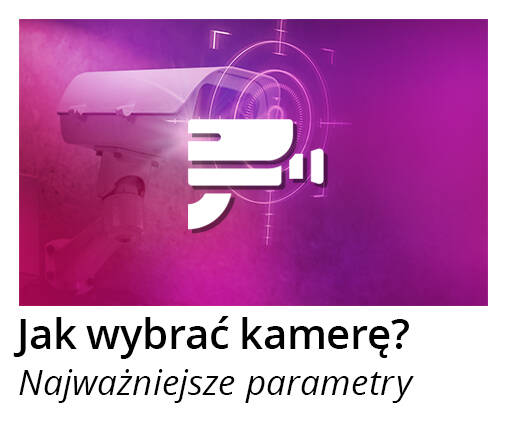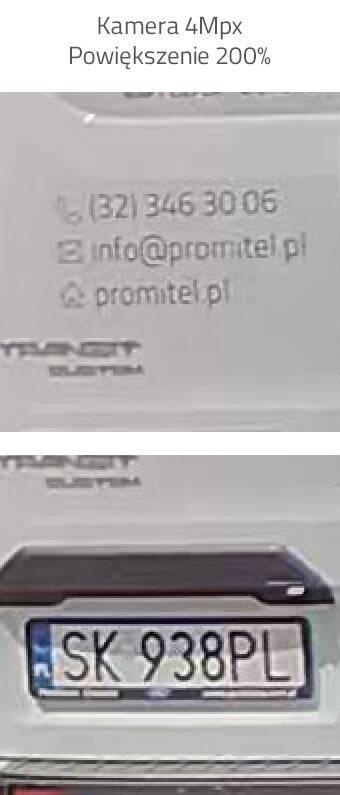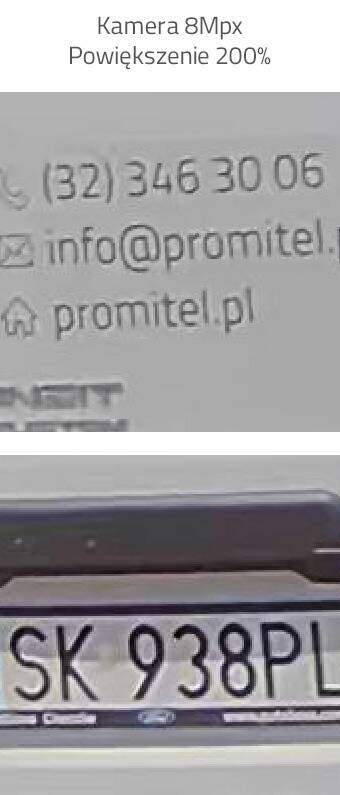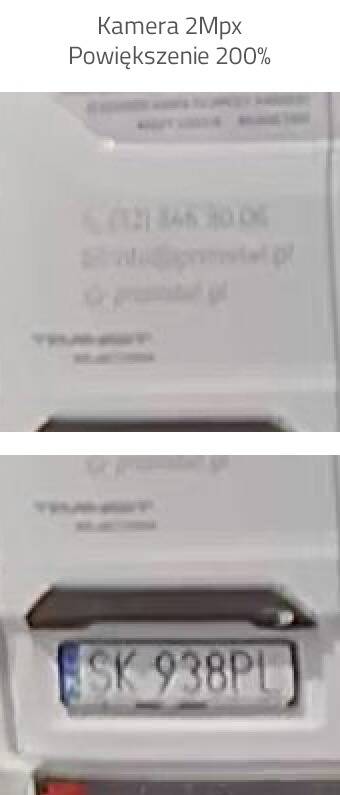How to choose a surveillance camera?
2019-09-26
How to choose a surveillance camera? If we want to plan the monitoring system ourselves, we are thrown into deep water. We have digital and analog systems to choose from.
How to choose a surveillance camera?
If we want to plan the monitoring system ourselves, we are thrown into deep water. We have digital and analog systems to choose from. Cameras and recorders have many different functions, the meaning of which we do not know. There are various types of device models on the market, so we need a lot of time to understand what each function is responsible for, what to pay attention to and what devices will be suitable for us. Below we will try to explain the most important functions and briefly describe what you need to pay attention to and which surveillance cameras to choose. Let's start by explaining the concepts related to the monitoring systems that we will use in the second part of the guide.
CCTV (Closed-Circuit TeleVision) – literally translated, it is closed-circuit television. A system for transmitting images from cameras to recording devices or monitors, with a limited area of operation. Used in all facilities where monitoring is necessary.
IR radiator – infrared illuminator is an additional camera equipment that allows you to illuminate the image (e.g. at night) in a place where it is not possible to use ordinary white light. Currently, most cameras use high-efficiency LEDs, and the radiators themselves have different ranges and angles of illumination.
WDR (Wide Dynamic Range) –is a function that allows you to obtain a wide dynamic range of exposure. Thanks to it, it is possible to obtain good visibility when there is a very bright point of light and a darker part in the frame. Without WDR, the light would blind the lens and the darker part would be invisible. WDR evens out the light levels for good visibility in both light and dark areas of the frame.
DNR (Digital Noise Reduction) – i.e. digital noise reduction. The function reduces noise or blurring of the image that occurs when the light level is full or insufficient.
EIS (Electronic Image Stabilization) – electronic image stabilization. A function in the camera that allows you to reduce camera shake caused, for example, by strong gusts of wind or ground shaking.
HLC (Hightlight Compensation) – technology to reduce the incidence of strong headlights. This application is perfect for license plate reading cameras.
BLC (Backlight Compensation) – function used in almost every camera, responsible for backlight compensation. Thanks to it, when the camera is exposed to a source of strong light, e.g. (the sun), the foreground will still be clear and well lit.
Motozoom – a function in the camera that allows optical zooming in and out of the image, without losing quality, as is the case with digital zoom.
EXIR – modern radiator, used in high-quality cameras. One diode allows for even illumination of the image. To prevent the cameras from blinding themselves, the illuminator is separated from the lens.
LPR (License Plate Recognition) – a function in the camera that allows you to download vehicle license plates. In many cameras that have this function, it is possible to integrate the camera, for example, with a barrier securing the entrance to the parking lot.
ROI (Region of Interest) – a function that allows you to improve the image quality of a selected area, while reducing the quality of the remaining area. Thanks to this, in the case of poor connection bandwidth, its load will be reduced, and it will also save space on the HDD.
H.265+ Compression – image compression standard. The h.265+ codec allows you to reduce the size of the saved data by over 80% compared to the first generation of codecs. Based on it, more than 4 times more cameras can be installed on an existing network.
FPS (frames per second) – number of frames displayed per second. Cinema movies are displayed at 24fps, movies on TV or on a computer are usually played at 24-30fps, and these numbers are needed for full smoothness of the picture. To save space on the disk, the cameras also offer high resolutions with a lower number of FPS, such as 6, 10 or 15. The film is then less smooth, and with fewer frames it turns into a slideshow, but when saving data, it is also important to quantity. A smaller number of frames will allow you to identify the intruder as well, and at the same time will allow you to keep recordings from a longer period.
ICR (Infrared Cutfilter Removal) – the mechanical infrared filter is the element responsible for controlling the infrared rays. When changing the light intensity, it is moved or moved away from the camera matrix. At night, it is removed from the sensor, which allows more light to reach, which results in brightening the observed plan.
Privacy Mask – a function in the camera that allows you to create a virtual mask on the recorded area. They are used to cover windows, for example, to respect the right to privacy.
PoE (Power Over Ethernet) – it is a technology that allows you to connect the power supply and the network with a single cable, without the need for an additional power supply. There are several PoE standards like Poe+, High PoE, Super-PoE.
P-IRIS – a function that allows you to adjust the lighting level, e.g. in closed, glazed rooms, and at the same time illuminated with strong light from the outside. By adjusting the opening of the aperture, more or less light is admitted to the matrix, so that the image is readable.
Auto-Tracking – a function used in PTZ cameras to track a detected object.
PTZ (Pan/Tilt/Zoom) – a function related to PTZ cameras that allows you to control the camera horizontally, vertically, as well as optical and digital zoom. Modern PTZ cameras have the ability to patrol specific routes, i.e. the configuration of the so-called presets: observing fixed points or auto-tracking.
ONVIF – a standard that allows you to record images when the recorder and camera come from different manufacturers. Through it, the user can configure audio and video settings, PTZ settings, and even relay inputs and outputs.
Turbo-HD Cameras – a line of analog cameras by Hikvision, recording images in HD quality, up to 4K. The cameras from this line do not require configuration, just power them and connect the second cable to the recorder to obtain video. Newer series have been equipped with hardware WDR 120dB, modern EXIR radiator or PoC technology (analogous to PoE, but for use in analog systems).
IP Cameras – a line of cameras characterized by higher resolutions, up to 12 MP, and with advanced image analytics, such as: crossing the line, signaling entering the selected area, detecting theft of an object, recognizing license plates, cameras with heat maps and people counting.
IP address – is the unique address of every device that is on the network. In the case of monitoring, it applies to IP cameras and recorders. Thanks to it, it is possible to connect directly to a given device in the network.
P2P (Peer to Peer) – better known as “Cloud”. A network service that in the case of CCTV allows you to connect to an IP camera, recorder, regardless of the type of connection: fixed, variable or mobile Internet. Recommended mainly to all users with a changing IP address who want to connect to the device without complicated configuration.
AWB (Automatic White Balance) – it is auto white balance. Another function used in cameras, through which the camera can correctly reproduce colors depending on the type of lighting.
AES (Automatic Electronic Shutter) – function responsible for automatic adjustment of the shutter speed, thus adjusting the exposure time to the prevailing lighting conditions.
DC (Direct Current) – designation of direct current, in which the direction and direction of current flow is constant. In the case of monitoring, the most commonly used method of powering the cameras.
AC (Alternating Current) – designation for alternating current in which the value of the current changes in a sinusoidal manner. AC current is mainly used in PTZ cameras.
Alarm output – it is an output used in recorders, it allows, for example, in the event of an intruder detected by the cameras, to notify the monitoring center so that it can react appropriately to a given event.
Switch POE – device used in monitoring, allowing to power IP cameras via PoE technology.
Auto-Focus – the term refers to a lens that automatically adjusts the focal length to obtain the appropriate sharpness of the image.
Bitrate – refers to the digital bandwidth over which you can determine how often data is transmitted. It is expressed in bits per second and the higher it is, the more data can be transferred.
CIF (Common Intermediate Format) – an image format with a resolution of 352×288 pixels referring to analog television.
Sensitivity – the term refers to the amount of light that is necessary to obtain a standard image from cameras. Most often it is expressed in the unit of light “lux”.
HDMI (High Definition Multimedia Interface) – high-definition audio and video interface. Most often it is used to connect the recorder with the monitor.
IP (Ingress Protection) – degree of protection, commonly referred to as the tightness class. It determines the degree of protection of the camera against external factors such as dust, rain or snow.
IK – degree of protection, commonly referred to as the resistance class. It determines the degree of protection of the camera against mechanical damage.
OSD (On Screen Display) – on-screen menu. The technology used in modern cameras, which allows you to configure its parameters on a computer or TV screen.
VGA (Video Graphics Array) – an interface for image transmission, used in recorders to connect to standard monitors.
Video Transformer –connector used to transmit the image from the camera to the recorder and from the recorder to the camera via a UTP cable (twisted pair).
Twisted pair cable (UTP cable) – a cable with 8 wires used for data transmission.
Coaxial cable – a telecommunication cable used to transmit a low-power variable signal. In CCTV systems, it consists of a coaxial cable and two power wires.
PINHOLE camera – a miniature camera, which due to its size can act as a spy camera or be used, for example, in ATMs.
Defog – technology that allows you to correct the camera image during difficult weather conditions, such as fog, snow, rainfall or smog, which can significantly reduce the visibility of the camera.


It is also important at what distance the camera should see in the dark, depending on this, you need to choose a model with the appropriate range of the IR illuminator. Standard cameras cover ranges of 15, 30, 40 meters or more. It is also worth checking if the radiator has SmartIR – thanks to this technology, the entire image is illuminated evenly. In older cameras, the beam was sent centrally, which resulted in underexposed edges of the area and overexposed center.
Cameras located outside are selected in the same way in terms of the criteria described above, but one must additionally remember about the tightness class of the device. The cameras are distinguished by the degree of protection against weather conditions: from no protection through IP64 to IP67. IP65 offers basic protection against water jets and IP66 against strong water jets comparable to strong waves. Outdoor cameras are also often far away from the area they are monitoring. Depending on the required image quality, the lens and resolution should be properly selected, so that even when using the zoom, you can get the right visibility. If the lens will face strong light, it is worth making sure that the camera has WDR 120 db or at least digital WDR, which will automatically reduce overexposed areas. Thanks to this option, if a person is standing on a background that is very bright from the sun, it will not be just a dark silhouette.
In this way, we were able to select cameras based on basic criteria. Of course, different devices can be connected within one system, which allows you to meet the criteria, while saving money. For example, if we want to identify people entering and staying in a building, we do not need to install all high-resolution cameras. A properly set camera at the entrance will allow you to record faces, cameras in the building with lower resolution will be enough to track a given person. If expectations regarding the vision system are higher, advanced functionalities can be considered. If you need good nighttime monitoring, you can consider ColorVu or DarkFighter. When we care about detecting intruders or other types of image analytics, you can delve into the AcuSense series or specialized cameras. Advanced functionalities of the systems can be seen on our website in the section intelligent solutions or monitoring possibilities.
If we do not need an extensive system or the installation of cables is difficult, you can consider monitoring with Wi-Fi cameras. This will allow you to obtain a satisfactory image quality, and at the same time will significantly minimize the assembly time. For those who value the appearance of space, smaller camera models or even miniature pinhole cameras may be suitable.
Selection of cameras is not an easy task, you have to take into account many variables, and also be well versed in technological possibilities. If you have any doubts about the choice of camera, please contact the sales department. Our experts have extensive experience and knowledge that will help you choose the right devices that meet all requirements.

